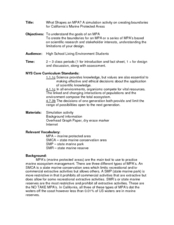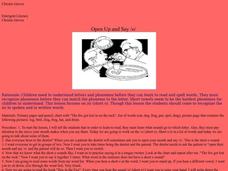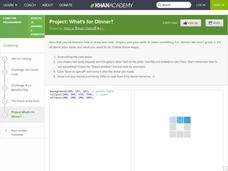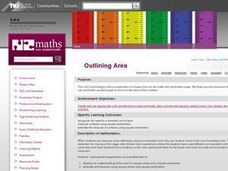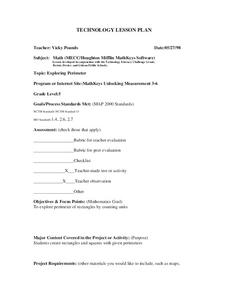Curated OER
What Shapes a MPA?
Students identify the three types of MPA in California. In this marine science lesson, students analyze information provided to design a new MPA. They justify their reasoning in class.
K6 Math
Area of Squares and Rectangles
More practice provided here for your young learners! They will find the area of two squares and one rectangle. There's open workspace for your learners to calculate the area. Note that the multiplication required to solve these problems...
Curated OER
Open Up and Say /o/
Students explore letters and phonemes. They discuss the phoneme /o/. Students recognize /o/ in both spoken and written words. They discuss the shape their mouths make when saying /o/. Students learn a tongue twister to help them identify...
Curated OER
Open Your Eyes Wide-Shut
Students improve their language skills through 11 activities. In this language skills lesson, students listen to picture books, answer questions about elements of a story, enhance their vocabulary and grammar skills, use 5 W questions,...
Curated OER
Geometry 2
In this geometry practice activity, students practice their problem solving skills as they reveal whether 5 shapes have open or closed curves.
Curated OER
Geometry: curves
In this curves worksheet, students identify the curves in the shapes given as being either closed or open. Students complete 5 problems total.
Khan Academy
Project: What's for Dinner?
This creative project may make your young programmers hungry as they practice their Java Script coding. The task is fairly open ended: add shapes using different shape functions, including the fill and stroke functions to add color and...
Curated OER
Outlining Area
Explore measuring various objects using square centimeters. Learners create various shapes using five centimeter cubes, calculate the area in square centimeters of different classroom objects, and discover who has the largest mouth,...
Math Tales From the Spring
Ice Breaker Activity - Name Reflections
Get to you know your new class members with an ice breaker activity that uses their name and creativity. Scholars write their first name in cursive on a folded sheet of paper, cut around the curved lines, open the paper to view its new...
Curated OER
Draw the Other Half
How can you make the two halves symetric? Scholars use the concept of symmetry to complete five images which are only half-drawn. The fun part about this exercise is that they aren't copying geometric shapes. There is a face, sun, kite,...
Illustrative Mathematics
Tossing Cylinders
Everyone loves a lesson that involves throwing things around! To understand probability, your experimenters will predict how different cylinder-shaped objects will land when tossed. When the data is collected, they will calculate the...
Museum of Science
Straw Bridges
There is never a bridge too far. Using common items, class members build bridges to span an opening. Pupils test different geometric shapes to determine which is the strongest. Learners use pennies to find the strength of their bridges...
Curated OER
Exploring Perimeter
Students explore perimeter. In this geometry and measurement lesson plan, students create squares and rectangles using given perimeters. Students construct four sided shapes with given perimeters using the computer program "Math Keys:...
Curated OER
How are Seeds the Same and Different?
Students examine seeds from various plants. In this science lesson, students cut open fruits and vegetables in order to see the seeds. Students describe each type of seed and classify the seeds.
Curated OER
Functions of Leaves
The title is a little deceiving since only one of 17 slides is dedicated to the function of leaves, while the rest is dedicated to the structure. Both internal and external structure is taught with accompanying diagrams. If you are going...
Curated OER
Solid Geometry
Eighth graders review solid geometry and measurement with a partner. They identify shapes and how they are measured then complete a word processing exercise on a computer. They exchange papers for grading.
Curated OER
A Honey of a Hexagon
Students explore how bees make honey and why the hexagon is the best basic pattern for the honeycomb through the use of a video and hands-on activities with honeycombs and geometric shapes.
Curated OER
Mystery Powders
Middle schoolers collect microscopic images from a variety of chemical specimens to determine the identity of a mystery powder. They use a ProScope Digital USB Microscope to describe and compare the crystal size and shape of the chemicals.
Curated OER
Family at Home
Students fold paper to form a house, then use three numbers to make fact families for their houses. They write a family of multiplication and division facts on a piece of paper cut in the shape of a house.
Curated OER
Nature Walk
Students participate in a mini field trip around the neighborhood to observe nature and changes that are occurring during fall. They collect leaves of various colors, shapes and sizes on their trip. Upon return to the classroom, they...
Curated OER
Paradise Lost, Books III and IV
A short synopsis of Book III from John Milton's Paradise Lost opens this presentation, which would be a good way to discuss a previous night's reading. The slide show goes on to address Book IV, first including the synopsis and then...
Curated OER
Introduction to Conics
Just exactly where does the name conic come from? This brief hands-on exploration explains it all. Have your class cut cones to create their own conics, then assess their understanding with a few identification problems. Consider making...
Virginia Department of Education
Dilation
Open up your pupils' eyes and minds on dilations. Scholars perform dilations on a trapezoid on the coordinate plane. They compare the image to the preimage and develop generalizations about dilations.
Curated OER
Easter Egg Surprise
Young readers describe objects by using describing words. After reviewing the five senses, they use their senses to gain information about an object. Then as homework, they write three descriptive words about a mystery object and place...
